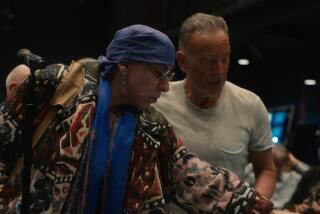Not at peace with events
- Share via
Tulare
As arguably the most gifted country music songwriter since Hank Williams, Merle Haggard has given his fans dozens of songs over the last 30 years that they’ll never forget; tales of yearning and heartache that chronicle the life of the common man with uncommon character and grace.
But Haggard has also written at least one song that some people will never forgive: “The Fightin’ Side of Me,” a love-America-or-leave-it anthem that was all over country radio during the height of the Vietnam War.
Though the recording struck such a nerve with Haggard’s core country audience that the words “Fighting Side” still appear on the red, white and blue T-shirts on sale at his shows, the song raised considerable ire among liberal Americans. So it felt like a redefining pop-culture moment last week when the white-haired performer sang a new song about the war in Iraq that even liberals might applaud.
Haggard’s “That’s the News” is a thoughtful, provocative commentary in which he asks why the U.S. government and media give the impression that the war is over although Americans are still dying in the Middle East.
Just moments after 1,000 or so fans attending the Electric Barnyard tour cheered a spirited rendition of “Fightin’ Side,” a hush fell as Haggard began the new song in this agricultural center, where an electronic sign on the edge of town states the time, the temperature and “God Bless America”:
Suddenly it’s over
The war is finally done
Soldiers in the desert sand
Still clinging to a gun.
No one is the winner
And everyone must lose
Suddenly the war is over
That’s the news.
It’s usually hard for audiences to absorb a song on first listening, and a few fans sitting on lawn chairs in front of the stage seemed puzzled about references to “tabloids” being back in style and “someone missing in Modesto.” But the crowd applauded strongly at the end. A few even held their beer cups high in salute.
The song’s key line is the one about the news, Haggard said earlier in the week in San Bernardino, another stop on the ambitious grass-roots tour that fellow singer Marty Stuart designed to reexamine country music’s small-town roots.
“It’s terrible what happened to that woman and her baby, but on the stage of world topics, how can that be the biggest news every day?” Haggard asked, referring to the apparent murder last December of Laci Peterson and her unborn son.
“Where is the importance? Who is calling the shots at the media, saying ‘Let’s take that feed from Modesto’? Doesn’t that make you want to say, ‘Hold it, we’ve got these men and women over there in Iraq’?”
Haggard was standing in the back of his custom tour bus on the National Orange Show Events Center grounds, and it was clear that he’s also frustrated by many of the issues surrounding the war --including the country’s long-range policy.
In another line in the song, Haggard sings:
Politicians do all the talking
Soldiers pay the dues
Suddenly the war is over
That’s the news.
“I’m the ‘fightin side of me,’ ” Haggard said. “I’m gung-ho about everything our armed forces do. God bless them. They are over there and we ought to be proud. I hope they still have some over here, protecting us. We seem to be spreading ourselves too thin. We are talking about going into some other country, going to liberate somebody else.
“What is this? Are we just sort of stumbling around in the dark? Is there any long-term plan at all or are we just running our own wars as we go?”
Asked if he feels there is any contradiction between the questioning of “That’s the News” and the flag-waving of songs such as “Okie From Muskogee” and “The Fightin’ Side of Me,” Haggard looked surprised.
“I think the guy who wrote ‘Fightin’ Side of Me’ was a patriotic American and I think the guy who wrote this new song is also a patriotic American,” he said.
At a time when country audiences appear eager for the ultra-macho approach of Toby Keith’s “Courtesy of the Red, White and Blue (The Angry American),” Haggard’s song is a brave statement, especially when country radio is nervous about the Dixie Chicks after the much-publicized protests against lead singer Natalie Maines’ anti-Bush comments in March.
Because of country radio’s emphasis on younger artists, Haggard, 66, has a hard time getting anything played on radio these days, but he is so proud of the new song that he is going to release it as a single to stations next month. It’s also the centerpiece of an album due on Haggard’s own label in the fall.
Meanwhile, he is previewing it on the Electric Barnyard tour, and the song defines in many ways the underlying purpose of the tour. On one level the caravan is a search for the soul of country music during an era when the desire for pop acceptance has caused many of the field’s stars to lose touch with its original everyman strains.
Different generations of country musicians and fans debate everything from instrumentation (how much steel guitar, how much fiddle) to wardrobe in working out their own definition of true country music. But the music’s lifeblood rests on the ability of artists to write and/or sing songs that speak with honesty and insight about the human condition.
“That’s the News” was the best festival evidence that country artists can still meet that challenge, but tour organizer Stuart also offered a song that touches convincingly on blue-collar sensibilities.
“Farmer’s Blues,” which appears on his new “Country Music” album, is about the struggle of family farmers, and you could see scores of older fans nodding in acknowledgment of such lines as, “Who’ll buy my wheat, who’ll buy my corn/ Feed my babies when they’re born.”
The festival’s guiding force doesn’t like to think of himself as a crusader, but there is a sense of mission about the tour.
Stuart is a flashy performer, with hair so long and full that he looks as if he’d have to take a lawn mower to it. But he’s got a deep, genuine love and understanding of country music. The Mississippi native, 44, played mandolin with Lester Flatt’s band as a teenager and toured with Johnny Cash for years before starting a solo career in the ‘80s, and he’s saddened by the lack of purpose and heart in country music these days.
After a break from touring to do some film scores and other projects, Stuart decided in 2001 to play some of the nation’s secondary markets rather than try to compete with the contemporary stars who fill arenas in big cities.
He enjoyed the experience so much that he came up with the festival concept, which includes a portable stage that is set up on fairgrounds and other rural sites. He recruited Haggard to headline the shows, and Waffle House restaurants -- talk about type casting -- signed on as a sponsor.
The four-week affair also features the Old Crow Medicine Show, a young acoustic band that mixes punk and traditional country influences. Connie Smith, Rhonda Vincent and BR5-49 rotate in rounding out the bill. Tickets are $25 in advance, $30 at the door.
“The concept to me was the old Roy Acuff traveling tent show or the Bill Monroe tent show,” Stuart said in San Bernardino. “Monroe even put the Bluegrass Boys in baseball suits and made them challenge the locals in a game.
“To me, there is something in this interaction that is pretty much at the heart and soul of country music, and I wanted to get back to that. It’s important to see this live on, and it will.”
The San Bernardino date lacked the warmth that Stuart is hoping to achieve. The stage and lawn chairs were on concrete, which made for a cold setting. But the grassy lawn and more rural feel in Tulare, just up Highway 99 from Haggard’s native Bakersfield, provided far more of the desired intimacy. As the tour moves on, it will stop at such other towns as Rome, Ga., Medina, Ohio, and Bean Blossom, Ind.
This was a hard-core country audience, most of which could easily qualify for AARP discounts. Some fans drove from as far away as Santa Cruz, though most came from neighboring towns. The surprise was that there weren’t more people on hand, considering that Haggard played such Bakersfield clubs as the Blackboard and the Lucky Spot before signing with Capitol Records and beginning a streak in 1968 of 65 Top 10 country singles in a row.
An old-timer in the crowd suggested one reason for the modest turnout was that fans may just take Haggard for granted after having heard all those hits for years -- from “Mama Tried,” the marvelous 1968 song about the wayward singer, who “turned 21 in prison,” to “If We Make It Through December,” an eloquent 1973 tale about a man trying to make ends meet for his family.
The achievement of this tour -- and a song as compelling as “That’s the News” -- is that it shows Haggard and heartfelt country music still have the ability to touch anyone willing to listen.
More to Read
The biggest entertainment stories
Get our big stories about Hollywood, film, television, music, arts, culture and more right in your inbox as soon as they publish.
You may occasionally receive promotional content from the Los Angeles Times.










